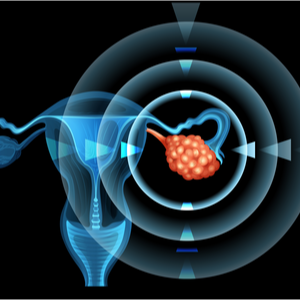
What is ovarian carcinoma?
Ovarian carcinoma is also colloquially called ovarian cancer. It is a malignant tumour of the ovaries, which are located on both sides of the uterus. Ovarian cancer is usually only diagnosed at an advanced stage, as the tumour has a relatively large amount of space to spread before it causes symptoms. By this time, the tumour may already have metastasised to the abdominal cavity. The risk of developing ovarian cancer increases with age. Women who have gone through the menopause are particularly at risk. Ovarian cancer before the age of 40 is relatively rare. In about 50 percent of all cases of ovarian cancer, both ovaries are affected.
How does
ovariandevelop?
Doctors distinguish between different types of ovarian cancer: On the one hand, ovarian cancer can develop from the ovarian cells. On the other hand, in 15 to 20 percent of all cancer cases, so-called germ-strand stromal tumours develop from embryonic germ-strands. Here, for example, the Brenner tumour should be mentioned, which only degenerates in 0.5 to 9 percent of all cases. Above all, women whose family members have already developed ovarian cancer have an increased risk of developing the disease. On the other hand, women whose menstrual cycle has started late and who have reached the menopause early are less likely to develop an ovarian tumour. Women who have had one or more pregnancies and have used hormonal contraception for a longer period of time are also less likely to develop ovarian cancer.
Ovarian cancer forms metastases relatively quickly, which spread mainly within the abdominal cavity and peritoneum
.
In some cases, the metastases can also spread to the liver, lungs, pleura or lymph nodes via the blood and lymph channels. Within the course of the disease, doctors distinguish between the following four stages according to the so-called FIGO classification:
- FIGO I: The cancer is in an early stage and initially only affects the ovarian tissue. Either one or both ovaries are affected.
- FIGO II: The tumour has already spread to the pelvis.
- FIGO III: Metastases have formed that extend into the peritoneum (peritoneal carcinomatosis) or into the lymph nodes.
- FIGO IV: The cancer is in a very advanced stage. Metastases can also be found outside the abdominal cavity and can reach into the lungs, for example.
What symptoms does ovarian carcinoma cause?
Ovarian carcinoma is usually only discovered at an advanced stage because the tumour has a relatively large amount of space in the lower abdomen to grow without causing any symptoms. The first symptoms usually only appear when the tumour presses on other organs due to its size or when metastases can already be found in other organs. The following non-specific symptoms, which can also be indicative of another disease, can occur:
- Abdominal discomfort, for example in the form of a feeling of pressure, sometimes accompanied by nausea
- general digestive problems, such as flatulence, an increased urge to urinate, constipation, bloating
- Increase in abdominal girth due to the production of abdominal fluid (ascites), despite constant or falling weight
- Listlessness, fatigue and/or tiredness
- Bleeding outside the menstrual cycle or bleeding after the menopause
- Fever and night sweats: occur mainly in the advanced stages
How is ovarian cancer diagnosed?
By palpating the abdominal wall and the female genital organs, the gynaecologist can already detect an ovarian tumour. A subsequent ultrasound examination (sonography) of the abdominal region and the vagina can provide information about the tumour size, location and condition. A computer or magnetic resonance tomography can show how far the tumour has already spread. But certain tumour markers can also be determined by a complete blood count. These include, for example, a higher amount of cell proteins, which indicate that metastases have grown. However, in order to make a definite diagnosis about the malignancy of the tumour, the doctor takes a tissue sample (biopsy) in a surgical procedure.
How is o
varian treated?
Ovarian cancer is usually treated with surgery or chemotherapy. In most cases, the patient is treated with a combination of both procedures. However, the exact treatment always depends on the stage of the cancer, the size of the tumour and whether the tumour has already metastasised, as well as the patient's general state of health.
Depending on whether the tumour could be completely removed, the patient's chances of recovery also increase. Both ovaries, the uterus and the fallopian tubes are usually removed in one operation. If the tumour was detected at an early stage or only one ovary is affected, only the tumour can be removed.
If,on the other hand, the tumour has already metastasised, parts of the peritoneum, the intestine or the appendix, or the lymph nodes, may also have to be removed.
The operation is usually followed by chemotherapy, which is intended to prevent possible tumour foci that could not or not completely be removed from growing further. Depending on the type of cancer, the chemotherapy drugs can affect the entire body or are administered specifically to the abdominal cavity.
The chances of curing ovarian
cancerAs with other types of cancer, the chances of curing ovarian cancer increase the earlier the cancer is detected. The 5-year survival rate for ovarian cancer is about 40 percent. Of all gynaecological cancers, ovarian cancer thus has the poorest prognosis for a complete cure.
a